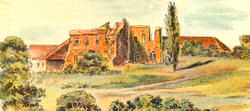Translating Russian Documents from Poland
On to Napoleonic Formats
On to Translation Resources
Getting Started With Russian Translation
These pages are designed to help English and German speaking researchers acquire the skills to translate Napoleonic church records written in Cyrillic. All examples are taken from records derived from
The first essential skill to learn is the ability to recognize the handwritten Cyrillic letters found on these old documents. It is helpful to correlate the script letters with the printed letters currently used in books or displayed on the computer. Here is an excellent table showing handwritten letters with their printed counterparts, and the corresponding phonetics of each character given in English, Polish, and German.
Examples of birth, marriage, and death Napoleonic records are provided on this site with word-for-word English translations given under each word/phrase. As we gain exposure to more writing styles over different years we will try to include additional examples of these translated records showing different writing styles. Note that these records have a definite format and usually the most important information can be gleaned by locating the important names and information associated with each name. Further details on the format of each type of record is presented on the Napoleonic Formats page.
Tables showing the Russian spellings of important words such as numbers, months, and certain critical terms are provided on these pages to assist the researcher to translate these important variables on each record. Handwritten examples of many of these are also provided on picture files detailing the conversion from handwritten letters to printed letters along with the English/German translation of the word.
Generally the most difficult aspect of translation is to decipher names of towns since no standard Russian spelling is given for Polish towns. We are building a collection of town translation examples in pictures ordered alphabetically according to the Cyrillic alphabet. Because the phonetics of German and Polish better resembles the phonetics of Russian characters than what the English language uses, a German phonetic translation is given in red underneath each handwritten town name. Above the town name the printed Cyrillic characters are provided in blue. Then the correct current day spelling of that town in Polish (or in rare instances a German name was used) is provided in black. These examples can be used to quickly learn how to read handwritten Cyrillic (letter-by-letter) and achieve a phonetic pronunciation of these town names.
In much the same way that town names are phonetically transcribed on the records, surnames of witnesses or godparents in particular (generally these are not converted into the Latin alphabet on records) are also derived phonetically by the use of Cyrillic characters. With the records from
To achieve the skill of interpreting Russian documents a certain level of patience is required with continual practice. The examples provided on this site should jump start your endeavor to obtain these skills. Occasionally a record will be encountered where it deviates slightly from the expected format, particularly birth records where the father may have died or the birth was illegitimate. When we encounter examples of these we will try to post translations to possibly help you with similar cases.
The best resource you can use whenever you get stuck is to find a native Russian speaker. Many have now come to
On to Napoleonic Formats
On to Translation Resources


